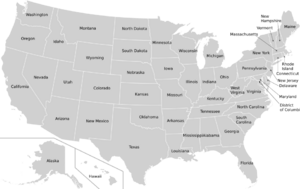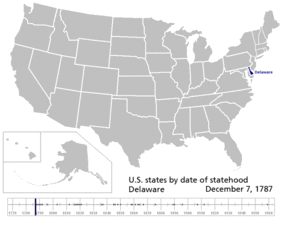List of U.S. states by date of admission to the Union facts for kids
A state in the United States is like one of 50 big parts that make up the country. Each state shares its power with the main U.S. government. This means people are citizens of both the whole country and the state where they live. Some states, like Kentucky and Virginia, use the word commonwealth instead of state in their official names.
States handle many things that affect people's daily lives. They have powers that the federal government doesn't have, and that the Constitution doesn't forbid them from having. For example, state governments manage things like local businesses, elections, local towns, public schools, and building roads. Every state has its own constitution and a government with three parts: a leader (executive), a group that makes laws (legislative), and courts (judicial).
All states and their people have a voice in the main U.S. government through the Congress. Congress has two parts: the Senate and the House of Representatives. Each state gets two senators, no matter how big or small it is. But the number of representatives a state gets in the House depends on how many people live there, which is counted every ten years in the census. States also choose people called electors for the Electoral College. This group votes to choose the President of the United States and Vice President of the United States. The number of electors a state gets is equal to its total number of senators and representatives.
The U.S. Constitution says that Congress can add new states to the country. When the United States started in 1776, there were only 13 states. Now there are 50! Every new state that joins becomes an equal partner with the older states.
Contents
When Did Each U.S. State Join the Union?
Here is a list of all 50 U.S. states and when they officially became a state. The first 13 states became states in July 1776 when they agreed to the United States Declaration of Independence. They then joined the first Union of states between 1777 and 1781 by agreeing to the Articles of Confederation, which was the first constitution.
The first 13 states below are listed in the order they approved the 1787 Constitution. This is the Constitution we still use today. For all other states, the date listed is the official date set by Congress.
| State | Date (joined or approved) |
Where it came from | |
|---|---|---|---|
| 1 | December 7, 1787 (approved) |
Colony of Delaware | |
| 2 | December 12, 1787 (approved) |
Proprietary Province of Pennsylvania | |
| 3 | December 18, 1787 (approved) |
Crown Colony of New Jersey | |
| 4 | January 2, 1788 (approved) |
Crown Colony of Georgia | |
| 5 | January 9, 1788 (approved) |
Crown Colony of Connecticut | |
| 6 | February 6, 1788 (approved) |
Crown Colony of Massachusetts Bay | |
| 7 | April 28, 1788 (approved) |
Proprietary Province of Maryland | |
| 8 | May 23, 1788 (approved) |
Crown Colony of South Carolina | |
| 9 | June 21, 1788 (approved) |
Crown Colony of New Hampshire | |
| 10 | June 25, 1788 (approved) |
Crown Colony and Dominion of Virginia | |
| 11 | July 26, 1788 (approved) |
Crown Colony of New York | |
| 12 | November 21, 1789 (approved) |
Crown Colony of North Carolina | |
| 13 | May 29, 1790 (approved) |
Crown Colony of Rhode Island and Providence Plantations | |
| 14 | March 4, 1791 (joined) |
Vermont Republic | |
| 15 | June 1, 1792 (joined) |
Virginia (nine counties in its District of Kentucky) | |
| 16 | June 1, 1796 (joined) |
Southwest Territory | |
| 17 | March 1, 1803 (joined) |
Northwest Territory (part) | |
| 18 | April 30, 1812 (joined) |
Territory of Orleans | |
| 19 | December 11, 1816 (joined) |
Indiana Territory | |
| 20 | December 10, 1817 (joined) |
Mississippi Territory | |
| 21 | December 3, 1818 (joined) |
Illinois Territory (part) | |
| 22 | December 14, 1819 (joined) |
Alabama Territory | |
| 23 | March 15, 1820 (joined) |
Massachusetts (District of Maine) | |
| 24 | August 10, 1821 (joined) |
Missouri Territory (part) | |
| 25 | June 15, 1836 (joined) |
Arkansas Territory | |
| 26 | January 26, 1837 (joined) |
Michigan Territory | |
| 27 | March 3, 1845 (joined) |
Florida Territory | |
| 28 | December 29, 1845 (joined) |
Republic of Texas | |
| 29 | December 28, 1846 (joined) |
Iowa Territory (part) | |
| 30 | May 29, 1848 (joined) |
Wisconsin Territory (part) | |
| 31 | September 9, 1850 (joined) |
Unorganized territory / Mexican Cession (part) | |
| 32 | May 11, 1858 (joined) |
Minnesota Territory (part) | |
| 33 | February 14, 1859 (joined) |
Oregon Territory (part) | |
| 34 | January 29, 1861 (joined) |
Kansas Territory (part) | |
| 35 | June 20, 1863 (joined) |
Virginia (50 Trans-Allegheny region counties) | |
| 36 | October 31, 1864 (joined) |
Nevada Territory | |
| 37 | March 1, 1867 (joined) |
Nebraska Territory | |
| 38 | August 1, 1876 (joined) |
Colorado Territory | |
| 39 | November 2, 1889 (joined) |
Dakota Territory (part) | |
| 40 | November 2, 1889 (joined) |
Dakota Territory (part) | |
| 41 | November 8, 1889 (joined) |
Montana Territory | |
| 42 | November 11, 1889 (joined) |
Washington Territory | |
| 43 | July 3, 1890 (joined) |
Idaho Territory | |
| 44 | July 10, 1890 (joined) |
Wyoming Territory | |
| 45 | January 4, 1896 (joined) |
Utah Territory | |
| 46 | November 16, 1907 (joined) |
Oklahoma Territory and Indian Territory | |
| 47 | January 6, 1912 (joined) |
New Mexico Territory | |
| 48 | February 14, 1912 (joined) |
Arizona Territory | |
| 49 | January 3, 1959 (joined) |
Territory of Alaska | |
| 50 | August 21, 1959 (joined) |
Territory of Hawaii | |
How the First States Formed: The Articles of Confederation
The Second Continental Congress agreed to the Articles of Confederation on November 15, 1777. This was the first set of rules for the new United States. The Articles officially started on March 1, 1781, after all 13 original states approved them. On March 4, 1789, the government under the Articles was replaced by the current federal government under the U.S. Constitution.
Here are the dates when the first 13 states approved the Articles of Confederation:
| State | Date | |
|---|---|---|
| 1 | December 16, 1777 | |
| 2 | February 5, 1778 | |
| 3 | February 6, 1778 | |
| 4 | February 9, 1778 | |
| 5 | February 12, 1778 | |
| 6 | February 26, 1778 | |
| 7 | March 4, 1778 | |
| 8 | March 5, 1778 | |
| 9 | March 10, 1778 | |
| 10 | April 5, 1778 | |
| 11 | November 19, 1778 | |
| 12 | February 1, 1779 | |
| 13 | February 2, 1781 | |
More to Explore
- Territorial evolution of the United States
- Missouri Compromise, a law from 1820 that allowed Missouri and Maine to join the Union.
- Toledo War, a border fight between Ohio and Michigan Territory that delayed Michigan becoming a state.
- Texas annexation, when the Republic of Texas joined the U.S. as a state in 1845.
- Compromise of 1850, a group of laws that included California joining the Union.
- Bleeding Kansas, violent conflicts in Kansas Territory before it became a state.
- Alaska Statehood Act, the law that made Alaska a state on January 3, 1959.
- Hawaii Admission Act, the law that made Hawaii a state on August 21, 1959.
- List of states and territories of the United States
- Federalism in the United States
- Ideas for a 51st state
See also
 In Spanish: Anexo:Estados de Estados Unidos por orden de ingreso a la Unión para niños
In Spanish: Anexo:Estados de Estados Unidos por orden de ingreso a la Unión para niños



